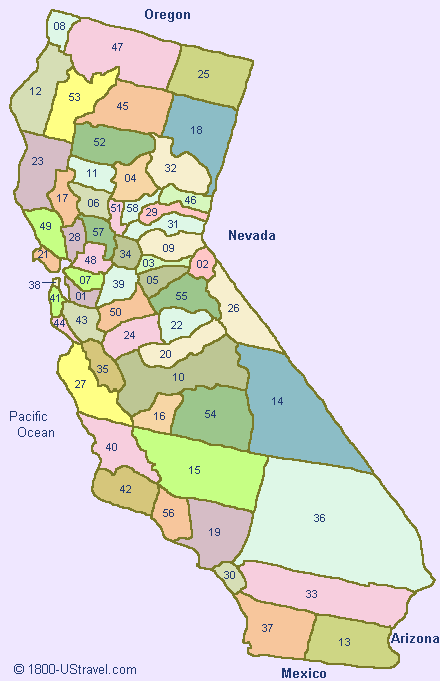California’s 58 Counties: History, Facts, and Travel Tips
California’s 58 Counties: History, Facts, and Travel Tips
Blog Article

Curious to know how many counties are in California? You’re certainly not the only one. Whether it’s for school projects, travel plans, or simple trivia, the magic figure 58 always surfaces, and stillthat short answer barely scratches the surface.
The Golden State’s 58 counties createa patchwork of contrasts: sun-drenched coastal hubs, high-elevation wilderness zones, fertile Central Valley breadbaskets, and global entertainment capitals. Each county carries its own story, moulded byrailroad expansion, high-tech revolutions, and waves of cultural fusion.
Over the next few pages, we’ll dig intohow the state’s county map froze at fifty-eight, the services counties deliver day-to-day, and the outliers that set fascinating records. Ultimately, you’ll have the numbers—and sound like a local expert with confidence.
Origins of California’s 58 Counties
On statehood day in 1850, the map looked nothing like today’s. A tidal wave of forty-niners and immigrants forced lawmakers to redraw borders. Before the century turned, the count had risen to 53 counties, and by 1907 the remaining gaps were closed, setting in stone the official total of 5 8.
Assembly journals reveal that fresh jurisdictions were born because of a trio of factors:
- Geographic isolation turned routine business into week-long trips.
- Revenue battles between miners and farmers sparked break-ups.
- Cultural rivalries wanted self-rule.
By 1920, the political map hardened. In modern times, even bold secession schemes rarely get ballot traction, leaving historians to label the era of county making truly closed.
From Kelp Forests to High Deserts: County Geography
Imagine a line from foggy Crescent City to border-side Calexico, and you’ll cross dozens of ecosystems. Pacific-facing districts soak up marine layers and mild winters, while great agricultural belts battle drought cycles.
- Mountain counties such as Placer, Nevada, and Alpine store California’s snowpack.
- Delta counties fight subsidence but export produce worldwide.
- Island counties like Los Angeles manage marine sanctuaries.
That geographic spread underpins the stark fiscal gaps between counties. Climate, after all, shapes crops and careers.
What Counties Actually Do
In California’s layered structure, cities tackle local bylaws, but counties are tasked with the bread-and-butter functions that make communities livable. Life’s paperwork trail—marriage licenses, tax rolls, voter registries—all reside at the county clerk or recorder.
Sheriff’s departments patrol towns too small for police forces, while superior courts hear civil suits. Health departments coordinate Medi-Cal. Funding debates occur in monthly Board of Supervisors sessions.
Example: Contra Costa’s Shared Services Model
Tiny Alpine operates from a single two-story courthouse, showing how flexible county structures can be. There’s no single blueprint when populations range from under 1 200 to over 10 million.
Ultimately, county halls act as middle managers between Capitol and curbside. Grasping their portfolio empowers voters.
Where the People and Money Are
Home to over 39 M souls, but that population clusters unevenly. LA County by itself hosts more than one resident in four. Conversely, tiny Alpine County rarely tops 1 200 inhabitants.
- Largest population: LA County
- Least populous: Alpine County
- Widest landmass: San Bernardino
- Smallest area: San Francisco
Fiscal bandwidth mirrors population spread. South Bay enclaves report six-figure median incomes, while cotton-and-almond hubs face commodity price swings. This revenue gap fuels housing affordability crises every decade.
Memorising these recordsis trivia gold: county metrics shape property taxes and commute times.
Touching All Counties in One Journey
County-collecting hobbyists, bagging all 58 jurisdictions has become a badge. A popular itinerary begins in the south-west corner, heads north along Highway 1, jogs east near Big Sur, then zigzags across the Central Valley’s orchard belt, before ascending into the Sierra Nevada for ghost towns and mining museums.
Breaking the Trip Into Segments
- South-land Loop – Border to wine country; ten jurisdictions in three days.
- Valley Ribbon – Ventura to Sacramento; flat-land express.
- Lava Beds Detour – crater-rim roads; jaw-dropping vistas.
Cap off the circuit in El Centro, having logged 1 400–2 000 miles. By then, you can confidently claim you know “how many counties California has”—because you’ve seen them all!
California County FAQ
Below you’ll find concise answers to the most common county-related queries.
How many counties are in California?
State records confirm 58 counties—a number that hasn’t changed since 1907. Check any authoritative source, and you’ll find the same figure: 58 in all.
Where do the most Californians live?
Los Angeles County tops the list, hosting a population greater than that of many U.S. states. Decades of immigration, entertainment dominance, and job growth keep the numbers high.
Least populous California county?
Tiny Alpine County sits at the bottom of the population chart, with fewer than 1 200 inhabitants. Its remote Sierra setting limits large-scale development, making it a haven for solitude seekers.
Largest county by land size?
The land-area giant is San Bernardino County covering a footprint larger than nine U.S. states. Its sheer scale means climate zones shift from alpine snow to Mojave heat within county lines.
Why does California have exactly 58 counties?
Early statehood growth pressures split larger districts into smaller units, with the final adjustments ratified in 1907. Since then, proposals to add a 59th county have surfaced but never cleared the Legislature.
Could a region break away to become its own county today?
Technically, number of counties in ca the California Constitution leaves the door open, though the process is arduous. A break-off region must gather local signatures, win a majority vote in each affected county, and secure legislative approval. Hence, California has remained at 58 for generations.
Which responsibilities fall to county governments?
Behind the scenes, counties keep daily life functioning: foster care, libraries, building permits, and superior courts. Remove counties from the equation, and civil society would struggle to operate.
Report this page